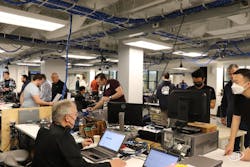Ethernet Alliance resumes live High Speed Networking Plugfests
After a COVID-induced hiatus, the Ethernet Alliance has resumed its series of High Speed Networking Plugfests at the University of New Hampshire’s InterOperability Labs (UNH-IOL; see, for example, "Latest Ethernet Alliance High-Speed Networking Plugfest has 97% pass rate"). The most recent edition, held April 24-29, 2022, brought together 18 member companies to evaluate the state of 100-Gbps and electrical lane support within the context of IEEE 802.3ck and 50-Gbps within IEEE 802.3bs.
The Ethernet Alliance originally planned to host this event last October, but postponed it due to the pandemic, said EXFO’s David J. Rodgers, Ethernet Alliance events chair. The organization offered a virtual participation option for this event, but Rodgers said that all the participants opted to come in-person to the lab. The event was open to Ethernet Alliance members; those who made the trip to Durham, NH, included:
- Amphenol
- Anritsu
- Arista Networks
- Credo
- EXFO
- Intel
- Keysight Technologies (including IXIA)
- Marvell
- NVIDIA (Mellanox division)
- Panduit
- Rohde & Schwarz
- Siemon
- TE Connectivity
- Tektronix
- Teledyne LeCroy
- VIAVI Solutions
- Wilder
- Xena
Rodgers said the participants brought just over 20 products and/or test instruments to participate in the interoperability exercises, which included more than 200 tests within the structured portion of the proceedings as well as several sidebar link ups. Products under evaluation included modules; cable assemblies that comprised direct-attach cables, active electrical cables, and active optical cables; network interface cards; switches; routers; and ICs. Higher Speed Networking Subcommittee Co-Chairs Kent Lusted of Intel and Pavel Zivny of Tektronix played active roles in organizing the event and overseeing its operation.
While official results are still being tabulated, the products appear to have shown a strong level of protocol interoperability and physical layer (PHY) specification compliance; Rodgers rated the overall performance of the test subjects an 8 out of 10. He commented that link initialization remains a focus, elements such as auto-negotiation and link training key parameters.
The interop was timely, Rodgers and Zivny pointed out within a blog posted on the Ethernet Alliance website, in that the IEEE802.3ck working group is preparing its final drafts for ratification. Results of the interop will be sent to the working group to aid in this effort. Meanwhile, the interop should give those who plan to use 100G lanes as building blocks for 400G product designs confidence as they move forward.
The Ethernet Alliance already has its sights set on the next interop, which will take place this October. Rodgers said the event likely will address any problems encountered in April as well as other parameters of interest.
For related articles, visit the Optical Technologies Topic Center.
For more information on optical modules and suppliers, visit the Lightwave Buyer’s Guide.
To stay abreast of optical communications technology, subscribe to Lightwave’s Enabling Technologies Newsletter.

Stephen Hardy | Editorial Director and Associate Publisher, Lightwave
Stephen Hardy is editorial director and associate publisher of Lightwave and Broadband Technology Report, part of the Lighting & Technology Group at Endeavor Business Media. Stephen is responsible for establishing and executing editorial strategy across the both brands’ websites, email newsletters, events, and other information products. He has covered the fiber-optics space for more than 20 years, and communications and technology for more than 35 years. During his tenure, Lightwave has received awards from Folio: and the American Society of Business Press Editors (ASBPE) for editorial excellence. Prior to joining Lightwave in 1997, Stephen worked for Telecommunications magazine and the Journal of Electronic Defense.
Stephen has moderated panels at numerous events, including the Optica Executive Forum, ECOC, and SCTE Cable-Tec Expo. He also is program director for the Lightwave Innovation Reviews and the Diamond Technology Reviews.
He has written numerous articles in all aspects of optical communications and fiber-optic networks, including fiber to the home (FTTH), PON, optical components, DWDM, fiber cables, packet optical transport, optical transceivers, lasers, fiber optic testing, and more.
You can connect with Stephen on LinkedIn as well as Twitter.

